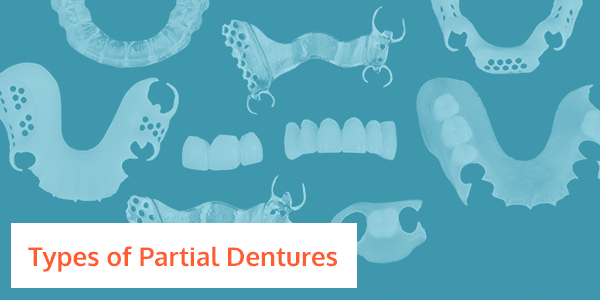Types of Partial Dentures
 If you’re facing an extraction or are getting around to finding a prosthesis to replace missing teeth, you’re likely considering a partial denture. A proven, reliable therapy, partials are much more affordable than implants, though you and your dentist will need to determine which type of partial denture is right for you.
If you’re facing an extraction or are getting around to finding a prosthesis to replace missing teeth, you’re likely considering a partial denture. A proven, reliable therapy, partials are much more affordable than implants, though you and your dentist will need to determine which type of partial denture is right for you.
The type of your partial denture you need depends upon your mouth and your needs, so you’ll need to speak with your dentist to determine what’s right for your case. In many instances, your dentist will recommend a partial to you, but knowing the basics of each type can help speed your decision.
What are partial dentures?
Partial dentures are removable dentures that take ht place of multiple broken or missing teeth in the upper or lower part of your mouth. These are more than just cosmetic devices: they can improve your chewing and speaking as well.
Partial dentures keep intact how the rest of your teeth fit in your mouth, which can move over time if you are missing teeth.
Partial dentures are not meant to be worn at all times. Many dentists recommend taking them out at night and cleaning them, which lowers the risk of developing cavities in nearby teeth because you are able to properly brush them completely.
Flexible Partial Denture
Harnessing the flexibility of modern heat-sensitive plastics, flexible partials fit better, and flex with the natural forces in your mouth when you speak or chew. Flexible partial dentures are also a better choice for those with allergies, as well as for those who consider metal and acrylic partial dentures uncomfortable.
Because they’re soft, many patients find them more comfortable than a rigid denture, and they don’t transfer bite forces to your teeth or gums, reducing irritation on your gums. And since they’re crafted to match your gum tissue, they’re typically the most esthetically pleasing prosthetic available.
While they’re comfortable and esthetic, flexible partials don’t function as well as rigid options. They’ll diminish your bite’s strength. In addition to their comfort, they’re difficult to repair should they break.
Cast Partial Dentures
This is one of the most common partial denture options, in part because they’re strong enough to last you many years. Built with an alloy framework, cast partial dentures may or may not be combined with acrylic to match your gum tissue.
Because they securely attach to your existing teeth with metal clips like acrylic partials, they mimic the function of natural teeth better, and don’t reduce bite force like flexible partials will.
They’re also made of metal, which means they’re fixable if they should break.
They’re not without their downsides. Cast partial dentures transmit temperatures to nearby tissue, so they can cause discomfort when drinking hot or cold liquids. Their metal clasps are often visible, so they offer a less esthetic option.
Additionally, people with fine motor skill issues often find it difficult to use the metal clasps on cast dentures in order to insert them. Cast metal dentures can also take longer to fabricate compared to flexible partial dentures.
Choose Alpine Dental Health for Your Partial Denture Options
Whether you choose cast or flexible partial dentures will depend mainly on your situation. Your dentist will look over your options and wellbeing in order to determine which option you are eligible for.
Regardless of which type of partial denture you and your dentist decide on, they are typically the least ideal solution for missing teeth. Less affordable options include dental bridges and implants.
Talk with our dentist to determine which prosthesis is ideal for your case and your budget.
